December 2009
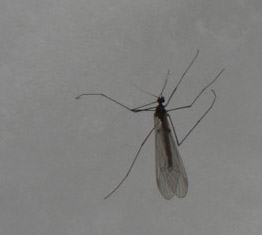
While on a walk at East Coulson Swamp, Oro-Medonte, on Dec 7 with 6 cm on fresh snow and a temperature of -1’C, I photographed this adult WINTER CRANE FLY. It is about 8 mm in length and was flying up from the snow,
making short, fluttery flights.
Presumably the ecological advantage of being an adult free flying insect, in the harshness of winter, is fewer predators as many insect eating birds have migrated south and so the chances of being eaten is less.
Photo and information by Margo Holt
November 2009
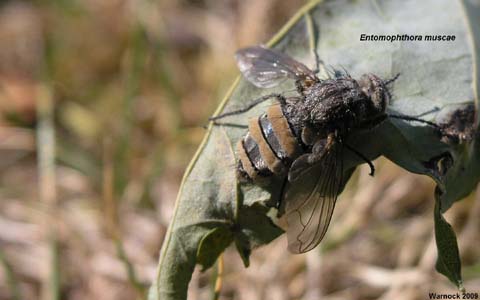
Entomophthora muscae “The Fly Destroyer”
In July, near Newmarket, Michael Warnock found several flies on maple leaves, which had been parasitized by the “ Fly Destroyer”. At the Cain
Foray near Huntsville in September, he found another and showed it to several members of our club.
It looked like an immobile honeybee, or wasp, due to the striped pattern of mycelium emerging from the abdomen. It was actually a dead fly, parasitized by a fungus, (as shown microscopically). A spore of the fungus is acquired by the fly, in its natural environment, on the exterior of its body. The spore then germinates and penetrates into the body of the fly (several families of Diptera are affected by this pathogen). Inside the body of its host, the fungus heads for the brain and tells it to climb to the top of the leaf , so that it can release the spores as high as possible ( almost like science fiction). The insect climbs upwards until the fungus has consumed a sufficient quantity of its body that it dies. Sporangiophores emerge from the abdomen of the fly, and produce spores, which are discharged in a radial pattern around it, so that it looks like a honeybee. Other flies that enter into this area of spore dispersal do so at their own peril, because of Entomophthora muscae “ The Fly Destroyer”. To learn more about this, go to: http://botit.botany.wisc.edu/toms_fungi/mar2000.html
Thanks to Michael Warnock, vice-president of the Toronto Mycological Society, for the photo and information.
October 2009 ( second find of the month)
How does a ( Midland Painted ) Turtle grow?
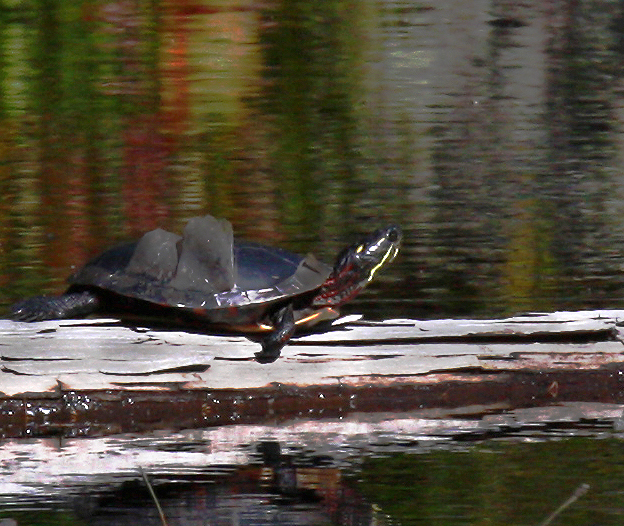
There are two main parts to the shell of a turtle: the upper portion is called the “carapace” and the bottom half is called the “plastron.” These two parts are joined by a bridge. The shells are covered with a layer of keratin (the same type of material that makes up our fingernails or horses’ hooves).
The keratin is arranged in patches called scutes, or shields. As a shell grows, the number of scutes does not change, but their size does.
It is common for a turtle to peel its scutes as a cleaning process and turtles that are particularly fond of basking do this. When a turtle basks in the sun, its body temperature rises and if there is anything on the turtle’s shell (like algae), it has a harder time absorbing heat and moving around in the water. Peeling the scutes sheds the layer that is dirty or clogged and replaces it with a fresh and clean layer. Peeling can happen at any time during the year. Some turtles start to peel when they start to hibernate and then, when they emerge from hibernation in the spring, they will often peel very rapidly.
On September 13, some members of the Orillia Naturalists’ Club were on a field trip to the Torrance Barrens, in association with the Field Botanists’ of Ontario’s AGM. When we looked up from seeing a rare plant, we saw this Midland Painted Turtle loosing its scutes. The photo is by Rod Lee, of Brighton
October 2009 – a SLIME MOULD : Arcyria denudata
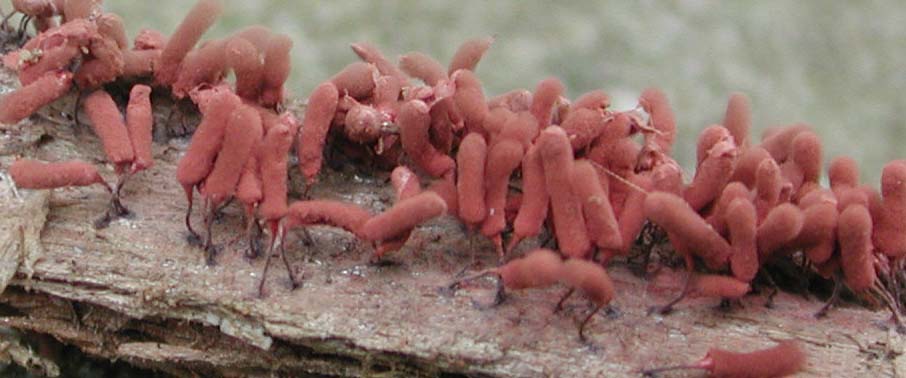
– animal or vegetable or –
Slime moulds (Myxomycetes) have two main life stages. In the first stage, the slime mould is a plasmodium, a slimy mass of protoplasm that slowly moves over substrates engulfing and feeding on bacteria, fungal spores, and small bits of organic matter. Like a giant amoeba, the plasmodium is very animal-like. When conditions are right, the plasmodium transforms into fruiting bodies which are immobile and produce spores, making slime moulds very plant-like.
These beautiful fruiting bodies ( much enlarged in this photo) were found on a log at Grant’s Woods. Touching these plumes produced masses of pink spores. Traditionally, slime moulds have been studied by mycologists (fungi people). However, slime moulds are neither animals, plants, nor fungi. They are slime moulds, in their own Kingdom.
Information supplied by Richard Aaron of the Mycological Society of Toronto
September 2009 – Ragged Fringed Orchid
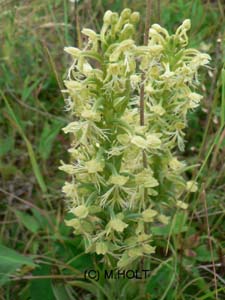
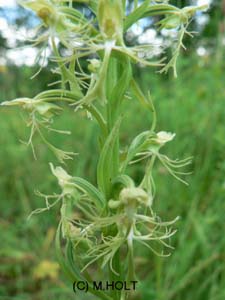
The Ragged Fringed Orchid (Platanthera lacera) is often difficult to find in weedy old fields because the yellowish-green flowers
blend in with the weeds and grasses of the field.
However, when you do find this orchid it is worth a close look as the flowers with their 3-parted lips that are deeply divided into
thread-like segments are quite beautiful.
While doing botanical inventories on the Carden Plain in July, we found this orchid at 2 locations in old field habitat with about 10 plants per location.
Photos and information supplied by Margo Holt
August 2009 – a look at what is inside
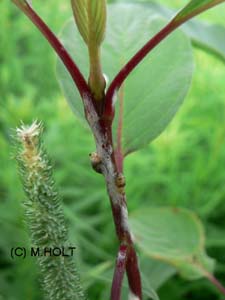
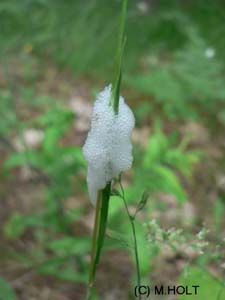
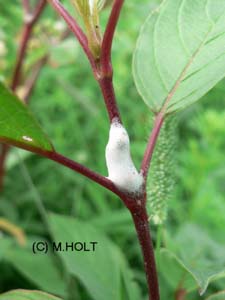
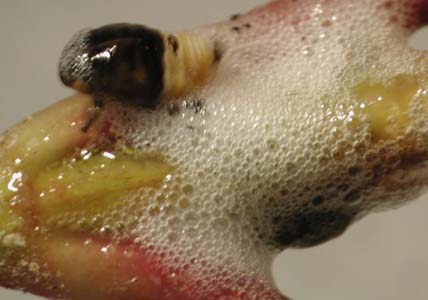
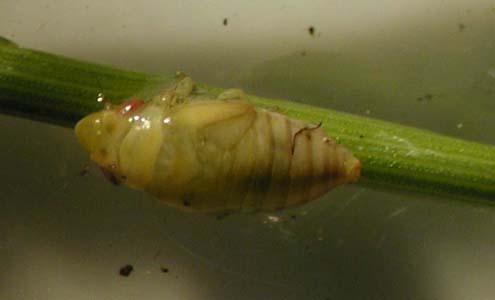
Meadow Spittlebug ( Philaenus spumarius) nymph: A European insect that was accidentally introduced and is now abundant.
Dogwood Spittlebug ( Clastoptera cf proteus) nymph: We found this on both Red osier Dogwood and Gray Dogwood.
Spittlebugs are not rare, but they can be exciting to watch under a hand lens, or a microscope. They feed by inserting their straw like beak into the plants, and sucking up the sap. But since they suck up the sap on the way up from the roots, instead of down from the leaves they suck in an enormous amount of excess water, which must be pumped out to form the characteristic bubbles. The bubbles are formed when the nymph contracts its muscles, squeezing the air canal, on the underside of the body , which opens out of the insects hind end. This is easily observed with a hand lens, after the spittle is scraped away. To find out more details of this interesting behavior, it is worth reading Stephen Marshall’s book – Insects Natural History and Diversity.
July 2009

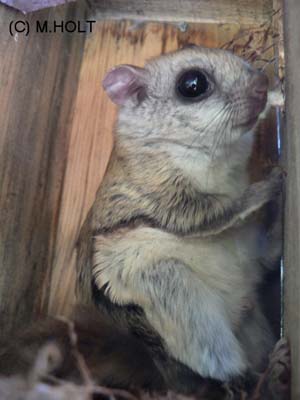 Who is that peeping out?
Who is that peeping out?
Why it is a Southern Flying Squirrel.
The Latin name, Glaucomys volans, means ‘grey mouse flying’. They don’t actually fly but glide from tree to tree by extending
the fold of skin that runs from forelegs to hind legs. These squirrels are nocturnal and their large eyes aid their night vision.
Two species of flying squirrel inhabit our forests. The Southern Flying Squirrel has white belly hairs, while the Northern has
grey belly hairs.
June 2009 Black Bear
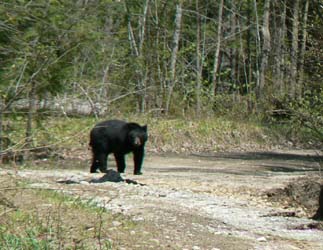
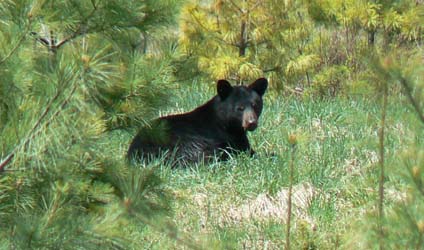
In the past the Orillia Naturalists’ Club often visited the road, which follows the Black River, past Cooper’s Falls, to Victoria Bridge. More recently it became an ATV and campers paradise, with all the attendant garbage and land destruction. However in 2006 it became Queen Elizabeth II Park. People were hired to carry out truckloads of garbage, and no overnight camping rules were enforced.
The Queen Elizabeth II Wildlands Provincial Park is a provincial park, between Gravenhurst and Minden. The park, named for Elizabeth II, Queen of Canada, is 33,505 hectares in size, making it the second largest park south of Algonquin Park , but it has a fragmented shape as a result of many private lands within its boundary.
Access is difficult in many areas because of private land. It was originally known as Dalton Digby Wildlands Provincial Park, after the two townships it encompassed. The park is one of the largest and least developed natural areas south of Algonquin Park. The park has a low rolling topography which includes organic soils, flat sandy deposits, wetlands, bare bedrock plain and bare bedrock uplands with shallow soil patches, characterized
by numerous rock ridges, including scenic cliffs and gorges, separating dozens of small lakes, rivers and streams.
Our club decided to visit again.
Donald Macdonald and Ray Kiff made a scouting visit, and found a culvert, difficult to traverse, but possible, with a high clearance vehicle. A second scouting trip, with Gord Michener (the trip leader), accompanying Donald Macdonald, found the road washed out and impassable, and a black bear patrolling the washout.
Donald submitted these photos of the bear, and a bug free fall trip is planned.
May 2009 Spotted Turtle
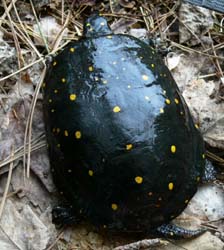
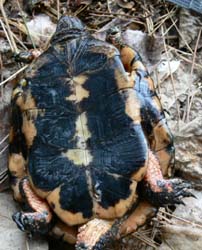 The Spotted Turtle is one of the first reptiles to emerge on the first warm days of spring, often when there is still ice and snow yet to
The Spotted Turtle is one of the first reptiles to emerge on the first warm days of spring, often when there is still ice and snow yet to
be melted. Their shells, black with an adorning of yellow polka-dots, shine like jewels in the shallow and clear waters that they spend much of their time in. However, when they crawl out onto grass tussocks and logs to bask in the spring when the water is still very cold, their shells turn to a chalky grey as they dry in the April sun. Once the turtle has basked enough to rejuvenate all it has lost during it’s arduous hibernation under the water, the Spotted Turtle leads an unusual life. They partake in a flurry of activity (involving feeding, mating, and egg-laying) until early June, then they often enter a form of “summer-hibernation” called (a)estivation. Then, as fall rains fill the shallow pools that they reside in, they are active again for a few weeks, before the snow and ice arrives in November or December.
The turtle in question was found in a shallow alder and sphagnum hollow, near Matchedash Bay. My attention was drawn to it, as it’s electrifying shell
pierced through the clear water atop the sunken red maple leaves of last autumn.
Thanks to Peter Mills of Barrie for the information and the photos of the plastron and the carapace of the spotted turtle.
April 2009 Striated Leafhopper
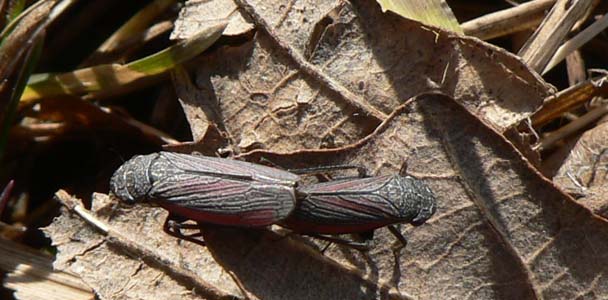 On a bright, sunny, & warm (13’C) St. Patrick’s Day (Mar 17), about 40 of these Striated Leafhoppers (Cuerna striata) were seen at Matchedash Bay. This brightly striped species overwinters as an adult & in early spring can often be found in the leaf litter & grass thatch. They are only about 8 mm long & were observed jumping or flying short distances to land in the leaf litter where the snow had melted away. Some were seen mating, as shown in the photographs. Leafhoppers are common jumping insects with about 2500 species in North America. Many are brightly coloured & they live & feed on all kinds of plants.
On a bright, sunny, & warm (13’C) St. Patrick’s Day (Mar 17), about 40 of these Striated Leafhoppers (Cuerna striata) were seen at Matchedash Bay. This brightly striped species overwinters as an adult & in early spring can often be found in the leaf litter & grass thatch. They are only about 8 mm long & were observed jumping or flying short distances to land in the leaf litter where the snow had melted away. Some were seen mating, as shown in the photographs. Leafhoppers are common jumping insects with about 2500 species in North America. Many are brightly coloured & they live & feed on all kinds of plants.
Update 2010
In the same location, near St Patrick’s Day, Striated leafhoppers were seen jumping around as they did the previous year
UPDATE 2011
In the same location, March 29, Striated leafhoppers were seen jumping around as they did the previous year. We have not seen them elsewhere at Matchedash Bay.
Thanks to Margo Holt for the photo and information. The insects in the photo are magnified by about 5x
March 2009
Lichens in Winter
Lichens can be found on the ground, on rocks or on trees. They can be divided into 3 growth forms – Crustose, Foliose and Fruticose. These photographed lichens were found on a bare granitic cliff face during the brief thaw this month. When everything else is brown or white, colourful lichens on trees and rocks stand out . Some of the technical words can be daunting at first, but they can be learned. Even if we cannot make accurate identifications , it is fun to look.
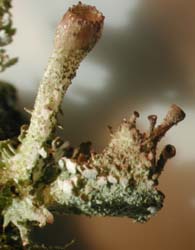
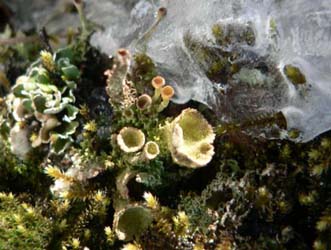
Cladonia chlorophaea ( which can grow on bark, soil or rock), has goblet shaped pixie cups arising from the thallus ( or vegetative body). Then more brown cups form on short stalks arising from the cup margins, almost like a castle.
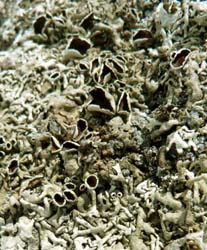
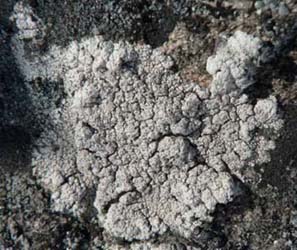
Xanthoparmelia cf. cumberlandia is an example of a foliose lichen, which forms large radiating patches, and has abundant brown discs ( apothecia), with inrolled margins. The apothecia, or cup-shaped sexual structures, where the spores develop, crowd the centre of the thallus.
This Dust lichen (?Lepraria) is an example of a crustose lichen -the hardest type to collect or study. It has no apothecia, but instead of sexual structures, it is a mass of soredia- the asexual structure- which may detach and land on another rock to propogate
Photos by Margo Holt
February 2009
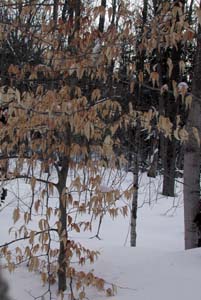
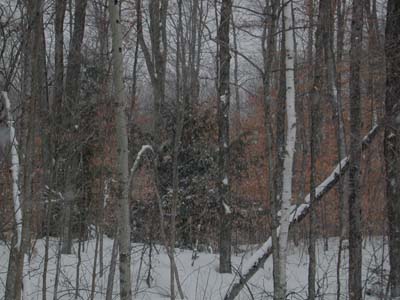 Marcescent (i.e. senescent leaves still attached to the branches) Beech Leaves. A beech woods is easily recognized in the winter, because of the retained leaves on the young beech trees. These leaves are not shed until spring. This is also true of ironwood (hornbean ) and oaks.
Marcescent (i.e. senescent leaves still attached to the branches) Beech Leaves. A beech woods is easily recognized in the winter, because of the retained leaves on the young beech trees. These leaves are not shed until spring. This is also true of ironwood (hornbean ) and oaks.
A Danish study showed that ironwood and beech were browsed significantly more when the leaves were removed. Chemical analysis showed that the stems of the beech and hornbean had a higher food quality than the leaves, which had a higher lignin content. The marcescent leaves reduced the nutritive value of winter
browse and so protected the young trees from browsing by moose and deer.
( This was not true of oaks, but they have a different mechanism for release of leaves.)
January 2009
NORTHERN HAWK OWL

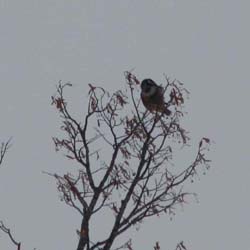
This photo, taken by Donald Macdonald, of a Northern Hawk Owl, on the Monck Road, near the 20th sideroad, on December 14/08. It was first sighted on December 9, but seems to be still hanging around this area.
On Wed 17th it was observed by Wendy Hutchings and Nancy Ironside. While we watched 3 Ravens flew by and landed. They commenced to call and fly around the Hawk-Owl, even causing the Hawk-Owl to duck its head at one point. After several minutes of this harassment, after 2 of the Ravens had flown away, the Hawk Owl took after the remaining Raven, and chased it into lower bushes. Obviously size is not everything, since the Northern Hawk-Owl is 41 cm (16 inches) and the Raven 61 cm (24 inches).
This is one of Ontario’s rarest owls, but is a casual winter visitor to our area. There are periodic invasions of this species into southern Ontario, such as 1906-7 when several were brought to Ottawa taxidermists. Apparently
there was a flight of major importance in the winter of 1962-63.
It has been recorded on Barrie Christmas Bird Counts in 1961 and in 1964. In 1966 a bird was observed (and photographed by W.E. Cattley) at Guthrie.
In 1991-92 a Hawk Owl was observed by Wendy Hutchings, and others at McMurchy’s farm, on Line 15, Oro/Medonte and it stayed at least until March 4/92.
The Orillia Xmas Bird Count (initiated in 1991) has 4 records –one in 1991, 2 in 1995, 1 in 2000, and 1 in the count week of 2001. This Owl on the Monck Road will not be in a Christmas bird count area. It is rare for Northern Hawk Owls to breed south of the boreal forest (most commonly found
breeding in the Hudson Bay Lowlands and Northern Shield, in Ontario).
POST SCRIPT:
A HAWK OWL WAS FOUND DEAD ON THE ROAD, WITH A MOUSE IN ITS CLAWS, ABOUT 3 WEEKS AFTER THIS PHOTO WAS TAKEN.
